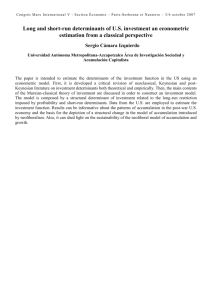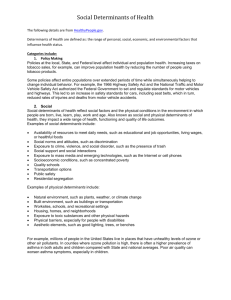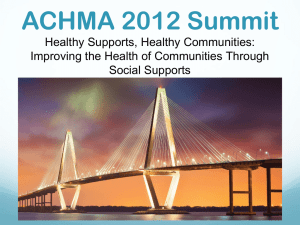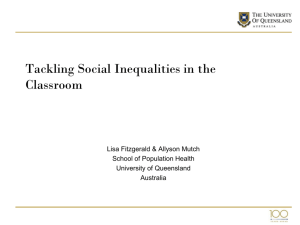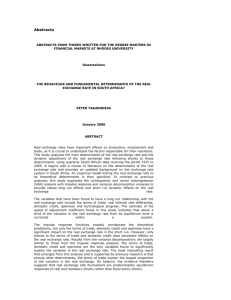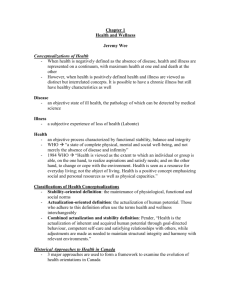What is Health? - Best Start Resource Centre
advertisement
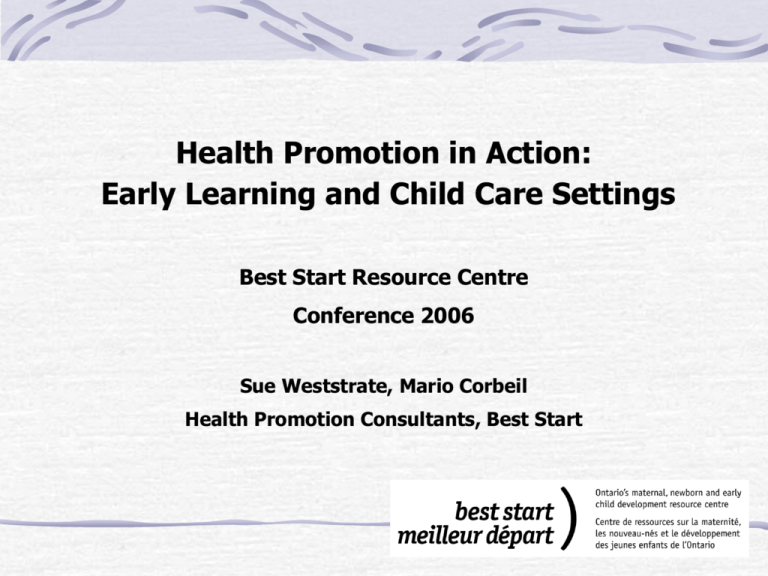
Health Promotion in Action: Early Learning and Child Care Settings Best Start Resource Centre Conference 2006 Sue Weststrate, Mario Corbeil Health Promotion Consultants, Best Start Welcome & Introduction, Context Objectives for this Session Presentation: The Determinants of Health; The Features of Health Promotion; Values of Health Promotion Small Group Work/Case Studies Reporting Back Large Group Discussion Best Start Resource Summary & Conclusion Objectives for this session Become familiar with/review health promotion, its values and features Identify and understand the relevance of health determinants and the above to early learning and child care settings Consider challenges and strategies for putting health promotion into action! What is Health? “Health is a state of complete physical, mental and social well-being and not merely the absence of illness or infirmity.” Seen as a resource for life Best practices that are founded on evidence-based research Canada spends $142 billion on health care, less than 5% of this, or $7.8 billion, on health promotion What is Health Promotion? Practices aimed at the planned change of human health-related behaviours: - individual behaviours - environment Strategies in Health Promotion Health education Social marketing and communication Policy change Organizational change Community change Ref.: O’Neill and Cardinal, 1994 The Determinants of Health [1] Public Health Agency of Canada identifies 12 determinants of health: 1. Income and social status 2. Social Support Networks 3. Employment and working conditions 4. Education and literacy 5. Social environments 6. Physical environments 7. Personal health practices and coping skills 8. Healthy child development 9. Biology and genetic endowments 10. Health services 11. Gender 12. Culture 1] Public Health Agency of Canada. What determines health? Retrieved December 9, 2005 from http://www.phac-aspc.gc.ca/ph-sp/phdd/determinants/index.html#determinants . Income and Social Status Higher social and economic status associated with better health Health status improves each step up the income and social hierarchy High income determines living conditions (safe housing, ability to buy sufficient nutritious foods) Healthiest populations are those where there is a more equitable distribution of wealth Control people have over life circumstances, especially stressful situations Social Support Networks Support from families, friends and communities is associated with better health Social support important in helping people solve problems and deal with adversity Caring and respect that occurs in social relationships, and the resulting sense of satisfaction and well-being, seem to act as a buffer against health problems Employment and Working Conditions Unemployment, underemployment, stressful or unsafe work are associated with poorer health More control over work circumstances increases likelihood of healthier status People who have fewer stress related demands at work tend to be healthier and often live longer than those in more stressful or riskier work and activities Education and Literacy Health status improves with level of education Education is closely tied to socioeconomic status Education gives people knowledge and skills for problem solving (helps provide sense of control and mastery over life circumstances) Education increases opportunities for job and income security, and job satisfaction Education improves people's ability to access and understand information to help keep them healthy Social Environments Civic vitality refers to the strength of social networks within a community, region,province or country Reflected in the institutions, organizations and informal giving practices that people create to share resources and build attachments with others In addition, social stability, recognition of diversity, safety, good working relationships, and cohesive communities provide a supportive society that reduces or avoids many potential risks to good health Physical Environments At certain levels of exposure, contaminants in our air, water, food and soil can cause a variety of adverse health effects, including cancer, birth defects, respiratory illness and gastrointestinal ailments In the constructed environment, factors related to housing, indoor air quality, and the design of communities and transportation systems can significantly influence our physical and psychological well-being Personal Health Practices and Coping Skills Actions that people can take to prevent diseases and promote self-care, cope with challenges, and develop selfreliance, solve problems and make choices that enhance health Greatly influenced by the socioeconomic environments in which people live, learn, work and play These influences impact lifestyle choice through at least five areas: - personal life skills stress culture social relationships and belonging a sense of control Healthy Child Development A powerful determinant of health The other determinants of health affect the physical, social, mental, emotional and spiritual development of children and youth e.g., a child’s development is greatly affected by: housing and neighbourhood, family income, level of parents' education, access to nutritious foods and physical recreation, genetic makeup and access to dental and medical care Biology and Genetic Endowment Biology and organic make-up of the human body Inherited predisposition to a wide range of individual responses that affect health status Even though socio-economic and environmental factors are important determinants of overall health, genetic endowment appears to predispose certain individuals to particular diseases or health problems Aging is not synonymous with poor health Health Services Health services, particularly those designed to maintain and promote health, to prevent disease, and to restore health and function contribute to population health The health services continuum of care includes health promotion, prevention, and treatment. Gender Society-determined roles, personality traits, attitudes, behaviours, values, relative power and influence that society ascribes to the two sexes on a differential basis Culture Some persons or groups may face additional health risks due to a socio-economic environment Such risks may be largely determined by dominant cultural values that contribute to the perpetuation of conditions such as marginalization, stigmatization, loss or devaluation of language and culture and lack of access to culturally appropriate health care and services The Features of Health Promotion[1] 1. Taking a Holistic View of Health 2. Taking Participatory Approaches 3. Building on Strengths 4. Addressing the Determinants of Health 5. Using Multiple, Complementary Approaches [1] HP 101 Online http://www.opc.on.ca Taking a Holistic View of Health “The whole child” The domains of development are interconnected (physical, social/emotional, cognitive/language) and programs must respond in kind e.g., literacy is incorporated into physical activities; social/emotional nurturing is part of mealtime Recognition that the child is part of a family and the family is part of a community Taking Participatory Approaches Doing things with people rather than for them Valuing everyone’s contribution and actively seeking it out Participation by parents, extended family members and the children themselves Building on Strengths Competency-based vs. deficit-based e.g., parenting programs that address problems in parenting may appear and feel judgmental and stigmatizing to participants, but a program model that acknowledges that all parents at some time require support will be a different, and more positive experience Also supports programs taking participatory approaches and building in the parents’ experiences, skills and making the program more responsive to parents’ needs Addressing the Determinants of Health The determinants of health are known A conscious effort is made to address determinants of health in strategic and program planning Using Multiple, Complementary Approaches Incorporating several or all of the features and values of health promotion and being open to additional ideas on which to build success The Values of Health Promotion[1] 1. Empowerment 2. Respect 3. Inclusion 4. Social Justice & Equity [1] HP 101 Online http://www.opc.on.ca Empowerment The cornerstone value of health promotion Health promotion is about people taking action on their own behalf (and on behalf of their children) to achieve and maintain good health Feeling empowered means feeling enabled: having the knowledge, power and authority to make decisions Choices are available and accessible Respect Valuing diversity Being open to and considerate of a diverse range of viewpoints, cultures and perspectives on health, wellness and parenting Challenging with dignity Acknowledging one’s own biases and seeking to be more inclusive Inclusion Access! Attitude! Addressing barriers and seeking to overcome them Key to participation Social Justice and Equity All of these values connect to social justice and equity The right to health and health care (including prevention and promotion) Health promotion, as an aspect of early learning and child care, is one more reason to advocate for child and family services and supports Bangkok Charter for Health Promotion Reflects these values 4 commitments: Make the promotion of health: central to the global development agenda a core responsibility for all of government a key focus of communities and civil society a requirement for good corporate practices CASE STUDIES Case Study 1: Toronto First Duty, Queen Victoria site Case Study 2: Breaking the Cycle, Mothercraft (Toronto) Case Study 3: Leeds, Grenville and Lanark District Health Unit Injury Prevention Program Case Study 4: Norfolk Community Help Centre Low German Family Education and Support Case Study 5: Cradle to Learning: Nipissing First Nations Early Years Centre For each case study, in small groups, identify: 1. How each program addresses the determinants of health 2. How each program incorporates the features of health promotion 3. How each program reflects the values of health promotion 4. How could this example be adapted? Large group discussion: 1. What are the challenges to put health promotion into action? 2. What are some strategies to put health promotion in action? 3. What are strategies for sustainability? Best Start Resource Summary and Conclusion
